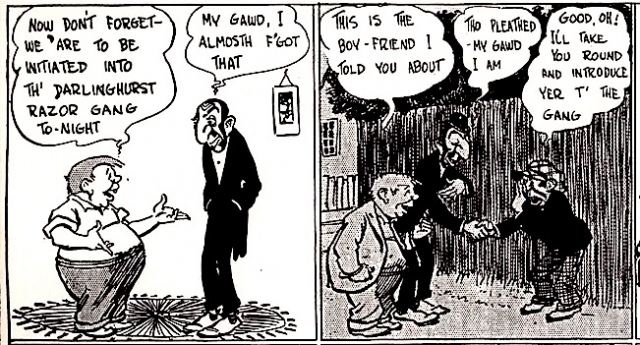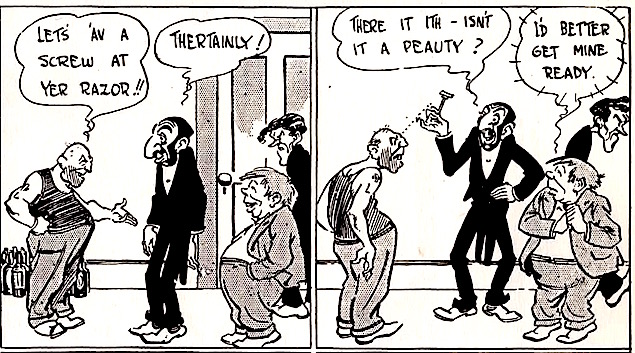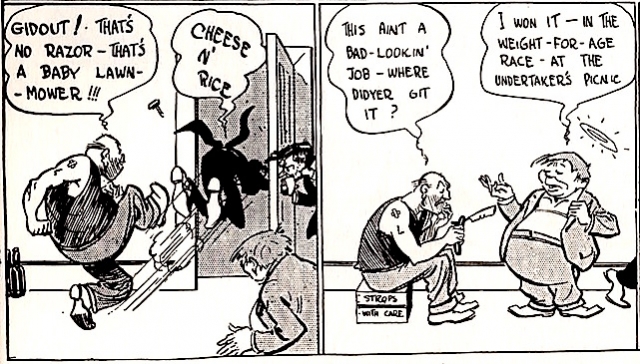Search
Recent comments
- stupid?....
3 hours 58 min ago - respite....
4 hours 8 min ago - highway to hell....
7 hours 3 min ago - earlier.....
9 hours 15 min ago - keep it up....
10 hours 23 min ago - censorcheese....
11 hours 21 min ago - EU u-turn?.....
15 hours 16 min ago - between warmongers....
1 day 9 hours ago - protection....
1 day 10 hours ago - laws are for....
1 day 10 hours ago
Democracy Links
Member's Off-site Blogs
the battle for the streets — the women of the razor gangs...
 mo...
mo...
The suburbs of Darlinghurst, Woolloomooloo and Kings Cross in Sydney, Australia, in the late 1920s and early 1930s was a world in turmoil with vicious ‘razor’ gangs battling for control of the criminal underworld. They were called razor gangs because of the cut throat razor (a straight shaving blade) that was the weapon of choice, especially after the Pistol Licensing Act of 1927 meant automatic gaol time for anyone caught carrying an unlicensed firearm.
The razor gangs at the heart of these wars were led by Tilly Devine and Kate Leigh. The upsurge in organised crime in the late 1920s is usually attributed to several factors:
- the prohibition on prostitution
- the prohibition on selling cocaine through legalised outlets such as chemists, and
- six o’clock closing of public bars and hotels.
Gang Leaders
The razor gangs at the heart of the razor gang wars of 1927-31 were led by two very different women: Tilly Devine and Kate Leigh.
Tilly Devine, known as the ‘Queen of Woolloomooloo’ ran a string of brothels centred around Darlinghurst and the Cross, and in particular, Palmer Street. Kate Leigh, known as the ‘Queen of Surry Hills’, was a sly groger and fence for stolen property.
Tilly and Kate’s battle for supremacy led to a running battle in the streets of Sydney that left many people dead, disfigured or doing gaol time.
Tilly's Story
Street walker
Matilda Twiss was born in Camberwell, London in 1900. She began working as a prostitute after she left school. Tilly was flirty, vivacious, buxom and pretty and she was soon earning good money. She met James Edward Devine in 1916 and it was a case of opposites attracting. Jim, or 'Big Jim' as he was known, was born in Victoria in 1892 and was serving as an Australian Digger in World War I. Jim was known to be sour and sullen and quick to temper. TIlly and Jim married in 1917 and soon had a son.
When Jim was repatriated home at the end of the war, Tilly followed soon after, leaving behind her infant son to be raised by her parents. She arrived in Sydney on 13 January 1920 on the Waimana, a "war bride" ship . Tilly is listed second from top as Mrs M Devine. She soon began working as a prostitute in Sydney while Big Jim provided her with protection. Tilly and Jim eventually divorced in 1943 after twenty-five years of marriage. Jim returned to Melbourne and died sometime in the 1960s.
Gaol term
By 1925 Tilly was well-known to police. In five years she had accumulated a long list of convictions; the numerous offences ranged from common prositute to indecent language, offensive behaviour and assault. The police report is a snapshot of the life that Tilly was leading upto 1925, a life that involved working the streets at night, clashes with Police and lots of parties and heavy drinking.
Tilly served two years in the State Reformatory at Long Bay for maliciously wounding Sydney Corke with a razor blade. The stint ‘inside’ convinced her to make some important career changes when she was released. She decided to start her own brothels rather than continuing as a street walking prostitute. Tilly was able to pursue a long career as a madam because the law stated that it was only illegal for men to live off the earnings of prostitutes. She quickly set up a number of brothels around Palmer Street when she was released from gaol. Big Jim also started selling cocaine out of the brothels.
Arch-enemy
Kate Leigh, born 1887, had a personal rivalry and enmity with Tilly that lasted for many years. They headed two of the most powerful razor gangs and were out to protect their own. Kate ran a sly-grog business which provided illegal alcohol after 6pm when the pubs had to shut. Both women were rich, powerful, violent and tried to outdo each other with furs and jewels. While Kate was a tough adversary for Tilly, she had a generous side and loved to be in court to see daily proceedings, sometimes bringing her vegetables to prepare for her evening meal.
Gang Members
Francis Donald Green (Frank Green) was born in Sydney in 1902. He became known as The Little Gunman, reflecting his stature of 1.65m. His gaol record shows that Green had brown hair and eyes, along with an L-shaped scar on his right cheek (a razor scar) and several bullet wounds on his body. Green worked as a gun for hire and Tilly used him to protect her brothels in the late 1920s. Green had an explosive temper, not helped by the fact he was an alcoholic and cocaine addict. Green had a falling out with the Devines after the 1929 shooting of Gregory Gaffney and he faded to obscurity before dying from stab wounds inflicted by his girlfriend in 1956.
Guido Calletti was born in Sydney in 1902. He was in trouble with the law from the age of eight and by the time he was 25 Calletti was the leader of the Darlinghurst Push, a small group of street brawlers and stand-over men. Calletti worked as a pimp, thief and hired thug, interspersed with periods of work as a labourer and co-owner of a fruit barrow. Calletti had an on-going love affair with Nellie Cameron (and rivalry with Frank Green) whom he eventually married in January 1934. Calletti died of gunshot wounds in 1939.
Sid McDonald worked as a bodyguard for hire and was employed by Tilly at the height of the Razor gangs wars. McDonald was born in Queensland in 1898 and had a string of minor charges and gaol time. McDonald took part in the gunfight at Tilly’s home in 1929.
Nellie Cameron was born in 1912 on Sydney’s North Shore. In 1926 she ran away from home and found work as a prostitute. Nellie was well known for her beautiful looks, sex appeal and hour-glass figure. Her relationships with gangsters (and their deaths) Norman Buhn, Frank Green and Guido Calletti, led to her becoming known as ‘the Kiss of Death Girl’. Cameron committed suicide in 1953, aged 41, after outliving her gangster lovers.
Read more:
https://www.records.nsw.gov.au/archives/magazine/galleries/tilly-devine-and-the-razor-gang-wars
Mo
Roy Rene (15 February 1891 – 22 November 1954), born Henry van der Sluys, was an Australian comedian and vaudevillian. As the bawdy character Mo McCackie, Rene was one of the most well-known and successful Australian comedians of the 20th century.
A 1927 recording of Rene and Nat Phillips performing as Stiffy and Mo, called The Sailors, was added to the National Film and Sound Archive of Australia's Sounds of Australia registry in 2011.[1]
Read more:
https://en.wikipedia.org/wiki/Roy_Rene
In the cartoon strip (STIFFY AND MO by Alex Gurney for Beckett's Budget 1928) at top, Mo wants to join the razor gangs... The next frames:
 mo2
mo2
 mo3
mo3
The next frame in the comment below... "Cheese N' Rice"? "Jesus Christ!" of course...
free Julian Assange now....
- By Gus Leonisky at 7 Nov 2021 - 9:53am
- Gus Leonisky's blog
- Login or register to post comments
the battle for the streets — continued...
First, the last frame of the cartoon above:
BACK TO THE PRESENT:
Organised crime is overpowering authorities in drug war, says veteran investigatorSophisticated organised crime networks are overpowering authorities as government “insanity” on drug policy fails to tackle the popular demand underpinning the trade in illicit substances, a veteran investigator has warned.
Tim O’Connor, who retired last month after almost a decade as head of criminal investigations at the NSW Crime Commission, said the entrenched approach to drugs was too reliant on policing and called for a greater emphasis on harm minimisation to turn users away from the products.
A generational effort to educate today’s children on the grim reality of drug production and the associated health risks is needed, Mr O’Connor said, so they do not become consumers in markets controlled by violent organised crime groups.
“The insatiable appetite that society has for prohibited drugs is generating massive revenue for organised crime ... It is a much bigger problem than anybody, including the government, realises,” he told The Sun-Herald.
“It has gotten to the stage now where organised crime has really honed their methodology and their skill sets to the point where they are overpowering law enforcement.”
He said police cannot “arrest our way out of the situation” because the irresistible windfalls offered by the markets for methylamphetamine, cocaine and other drugs would continue to motivate people to get involved despite the risks.
‘We need a generational change. We have to start off with young children today – who are going to be the drug buyers in future – and give them proper education as to why drugs are bad.’
Tim O’Connor, retired NSW Crime Commission head of criminal investigationsEven if law enforcement agencies had significantly more funding and brought to justice the kingpins who use global and technologically advanced networks to orchestrate major imports, other figures would step up to satisfy the market, Mr O’Connor said.
“The definition of insanity is doing the same thing over and over again and expecting a different result. It is clearly not working. Drugs are probably worse now than they have ever been,” he said.
The comments, from an experienced law enforcement official who has spent decades heavily involved in organised crime investigations, add to concerns recently aired by Australian Federal Police Assistant Commissioner Nigel Ryan about 90 per cent of criminal networks operating unchecked.
Mr O’Connor, who was a NSW Police detective in the 1980s and 1990s before joining the commission, urged the state government to act on the landmark ice inquiry, which in January 2020 handed down 109 recommendations designed to tackle drug use.
Attorney-General Mark Speakman previously said a response was imminent and drug consumption had to be viewed as a health issue. In an interim response to the ice inquiry, the government under former premier Gladys Berejiklian rejected outright five recommendations, including supervised injecting centres and pill-testing.
Ms Berejiklian’s government also backed away from a proposal for a three-strike policy for people caught with drugs, with penalty infringement notices handed out three times before a criminal penalty is imposed.
NSW is expanding the specialist Drug Court, which seeks to keep drug-dependent offenders out of prison, to four locations.
Mr O’Connor said the federal government was failing to advance “long overdue” laws that could have a real impact on organised crime networks by targeting the money laundering arrangements they depend on to legitimise the proceeds of their activities.
Facing hostility from industry groups, a tranche of planned anti-money laundering laws to impose tougher reporting requirements on lawyers, accountants and real estate agents whose expertise is critical for the sophisticated processes used by criminals has not been passed.
A register of beneficial ownership is also needed to determine the actual owners behind entities who can currently be obscured from authorities by complex corporate structures, Mr O’Connor said.
Read more:
https://www.smh.com.au/national/nsw/organised-crime-is-overpowering-authorities-in-drug-war-says-veteran-investigator-20211026-p593cv.html
IT IS A CRIME TO KEEP JULIAN ASSANGE IN PRISON.